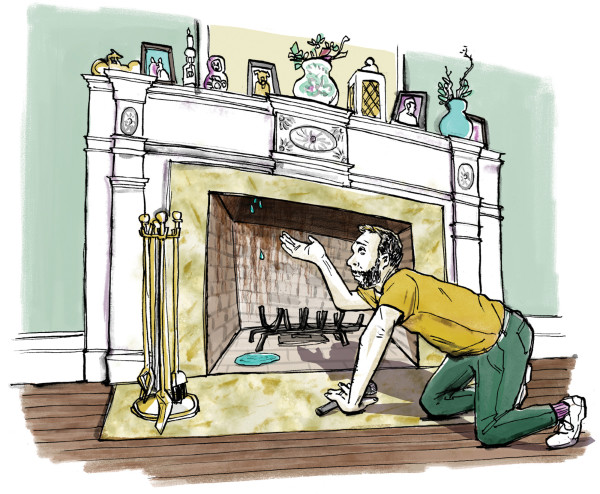
Illustration: Brett Affrunti
We’re lucky to have a working fireplace in our 1920s Colonial Revival, but lately we’ve noticed drips and moisture on the firebox floor. The chimney flashing is in good condition, there’s no sign of efflorescence inside or out, and we had the firebrick replaced when we moved in! We’re struggling to figure out what’s causing this failure. —Miles and Maya Burke
THE FIREPLACE FIX
Moisture may appear on the walls or floor of a fireplace (with chimney and flue) for many reasons. Rainwater can be driven through cracks on the chimney’s exterior and percolate through to the firebox. It may leak through damaged or failing flashing where the chimney projects through the roof. Or it may result because the chimney crown is damaged, or just because the flue lacks a cap.
Since you mention that the flashing and the firebrick are both in good condition, it’s likely that rainwater is coming in through the flue some other way. The simplest reason could be that the chimney lacks a cap. Standard caps are usually slightly inverted, roof- or barrel-shaped elements made of stainless steel, copper, or another metal, which rests atop a mesh sleeve that attaches to the top of the flue. You should be able to tell whether you have a cap or not through a visual inspection from the ground.
If your chimney lacks a cap, you should certainly have one installed. Without a cap, rain can fall straight down into the flue. The cap’s meshed sleeve also helps keep birds, bats, and debris out of the chimney. A copper cap in an architectural shape is an especially nice gift to the house.
If the cap is sound, the culprit could be the chimney crown. The crown is a 2″ to 3″ thick concrete or mortar slab, poured at a slight slope, on the very top of the chimney. It covers the top course of bricks and acts as an umbrella for the chimney structure.
If the crown is cracked or damaged, water and moisture can seep into the chimney, starting deterioration from the inside out. Minor cracks can be patched with an elastomeric sealant (brands include CrownSeal and Chimney RX). Larger cracks are a sign that water is getting into the flue. In this instance,
the best solution is to remove the crown and replace it with a new one.







